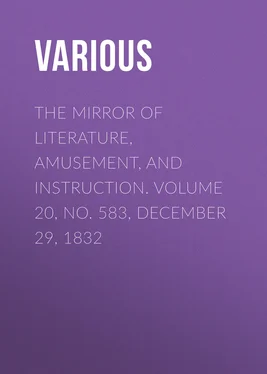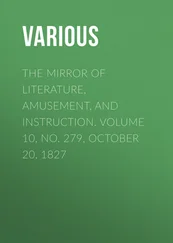Various - The Mirror of Literature, Amusement, and Instruction. Volume 20, No. 583, December 29, 1832
Здесь есть возможность читать онлайн «Various - The Mirror of Literature, Amusement, and Instruction. Volume 20, No. 583, December 29, 1832» — ознакомительный отрывок электронной книги совершенно бесплатно, а после прочтения отрывка купить полную версию. В некоторых случаях можно слушать аудио, скачать через торрент в формате fb2 и присутствует краткое содержание. Жанр: foreign_antique, periodic, Развлечения, foreign_edu, на английском языке. Описание произведения, (предисловие) а так же отзывы посетителей доступны на портале библиотеки ЛибКат.
- Название:The Mirror of Literature, Amusement, and Instruction. Volume 20, No. 583, December 29, 1832
- Автор:
- Жанр:
- Год:неизвестен
- ISBN:нет данных
- Рейтинг книги:4 / 5. Голосов: 1
-
Избранное:Добавить в избранное
- Отзывы:
-
Ваша оценка:
- 80
- 1
- 2
- 3
- 4
- 5
The Mirror of Literature, Amusement, and Instruction. Volume 20, No. 583, December 29, 1832: краткое содержание, описание и аннотация
Предлагаем к чтению аннотацию, описание, краткое содержание или предисловие (зависит от того, что написал сам автор книги «The Mirror of Literature, Amusement, and Instruction. Volume 20, No. 583, December 29, 1832»). Если вы не нашли необходимую информацию о книге — напишите в комментариях, мы постараемся отыскать её.
The Mirror of Literature, Amusement, and Instruction. Volume 20, No. 583, December 29, 1832 — читать онлайн ознакомительный отрывок
Ниже представлен текст книги, разбитый по страницам. Система сохранения места последней прочитанной страницы, позволяет с удобством читать онлайн бесплатно книгу «The Mirror of Literature, Amusement, and Instruction. Volume 20, No. 583, December 29, 1832», без необходимости каждый раз заново искать на чём Вы остановились. Поставьте закладку, и сможете в любой момент перейти на страницу, на которой закончили чтение.
Интервал:
Закладка:
August 20. Down at the Abbey this night. It would be absolute folly to note down what I saw or thought of this most remarkable monastic structure. Every album possesses it, in all the beauty of its fairy architecture; its tabernacles, its niches and canopies, and statues, pinnacles, pediments, spires, and the tracery of its vaultings.
The decorated work is most exquisitely executed. The mouldings are still so sharp, that they seem as lately from the chisel of the mason. The south transept window and door are the most perfect of the ruins. The day light of the window is twenty-four feet by sixteen, divided by four mullions. The tracery and cuspings are all of the decorated style of the Gothic. It is furnished with crotchets and creeping foliage. There are a number of niches, canopies, and tabernacles, on the south transept; and the corbels that support the statues, are carved with grotesque figures; some representing monks with cowls upon their heads, others musicians playing upon different kinds of instruments; some are most hideous to look at. Sir Walter procured casts of many of these grotesque figures, which on a visit to Abbotsford, I observed placed in the ceiling of the hall. He has clothed them in a new dress, more suited to the social scene of their present locality. But, I always ramble into the shop , when I get on architecture. Let me narrate the occurrence of this night. As I was pacing the great aisle of the abbey, a carriage drove up to the gate. "Sir Walter Scott!" said the keeper, brushing past me to receive him. A lady alighted. I heard "good night!" responded by a person in the carriage, who drove off with it. Who can this be, thought I to myself. It was dusk—the lady advanced with a stately step. I moved aside. "In these deep solitudes and awful cells!" methought I heard her say. She ascended to the bell-tower. "Who is that lady?" said I to the keeper when he entered. "That, sir," said he, "is Mistress Hemmins, the poet writer, wha is on a visit to Maistre Lockhart, and she cam just noo in Sir Walter's carriage, and she wants to be alane, sir, by hersel." I took the hint, and made for the George and my glass of toddy, unwilling to deprive the world of those lays, which Melrose, the rush of the Tweed, and midnight would, no doubt, inspire in the fair authoress.
August 23. At Galashiels, a semi-rural demi-manufacturing town on the banks of the "braw, braw Gala water." Not having the good fortune to get to Abbotsford from Melrose, I started over the hill which looks down on Galashiels, towards that destination. Abbotsford I need not render an account of. But my approach to it was not deficient in interest.
On arriving at the summit of the hill overlooking the Tweed, it burst upon my sight. I looked down on the grounds in which it is settled, as on a map. The skill and industry of Sir Walter is not more remarkable in his literary than in his rural works. The house stands in a bare, barren corner of Selkirkshire, (I think) but by admirable management, he has enclosed it with fine, hardy young wood, and quite altered its appearance.
At the bottom of the hill I took the boat at the ferry, and resting in the middle of the stream, the Tweed, and looked around me. I saw a person on the opposite bank appearing and disappearing in the wood which comes down to the water's edge. I drew near. He was dressed in a short, green coat and cap, and was amusing himself with the antics of a large dog. The place—the time—the air—the gait—every thing conspired: "Who's that, lassie?" said I to my little boat rower; "That, sir? that's himsel , that's the shirra" (sheriff.) Yes, it was the man—he himself—the pride of Scotland—her boast—the intellectual beacon of her hills—it was Sir Walter Scott!
Sept. 3. At Selkirk. At Mitchell's Inn, where I was introduced to the celebrated Jamie Hogg, the Ettrick Shepherd. He had come, I think, from a fair held at the Eildons. We got over a jug of toddy. Our conversation turned on the church service of the kirk of Scotland, and we rambled into poetry in conversing on the psalms. I pointed out to the shepherd, that a fair fame might be achieved by arranging the Psalms of David, and superseding the barbarities of Sternhold and Hopkins. James maintained that the present edition in use in Scotland, could not be improved. He said that the question had been agitated in the General Assembly, and Sir Walter Scott was applied to, to furnish an improved versification, but he answered, stating that it would be a more difficult matter to get the people to adopt them, than to furnish the same. Any alteration in this respect would be looked upon as little better than sacrilege, and he therefore advised that the present form should be continued in. "Watty's a sensible chap," said the shepherd, speaking familiarly of Sir Walter, "and if he laid a finger on o'or venerable psalmody, I wad pitch a louse at him, wha hae ever loved the man as my ain brether."
During the last years of Sir Walter's life, he visited in the counties of Berwick, Roxburgh, and Selkirk, the various scenes which his graphic pen has delineated and incorporated in his minstrelsy and romance. The summer when the preceding notes were made, I happened to be in Kelso, and took ride one day to visit the worthy minister of a neighbouring parish, in which the celebrated border keep Smailholme tower is situated, the scene of the fearful legend embodied in the poem "The Eve of St. John."
We rode over to it: it is situated on a crag or ridge of rock, high in the north range of hills, the Lammer-muir, which spring from the splendid vale of Teviot and Tweed, commanding an unbounded prospect on the east and west; the south is terminated by the Cheviots and the English border.
We found the Tower in possession of a party, and the Rev. Mr. C– rode forward to report, in case we should be deemed intruders. He came back shortly, and it was no other than Sir Walter himself, with several members of his family, who had accompanied him to bid a final farewell to Smaillum keep . As I afterwards heard, he was in the highest spirits, and repeated the poem for the gratification of his party, in that impressive manner for which he was remarkable, in giving the necessary effect to his own compositions. The party brought a cold collation with them: before leaving, Sir Walter surveyed the beautiful prospect at his feet, the Tweed and Teviot meeting in sisterly loveliness, and joining their waters in the valley, with the golden fields of England in the distance; when filling a glass of wine he drank with fervour, in which all joined him, "baith sides of the Tweed."
OLD ENGLISH ARMOUR
Previous to the time of Edward I., the body-armour may be distinguished by the appellations of trelliced, ringed, rustred, mascled, scalad, tegulated, single-mailed , and banded . The trelliced method has not been properly ascertained: it probably consisted of leather thongs, crossed, and so disposed as to form large squares placed angularly, with a round knob or stud in the centre of each. The ringed consisted of flat rings of steel, placed contiguous to each other, on quilted linen. The rustred was nothing more than one row of flat rings, about double the size of those before used, laid half over the other, so that two in the upper partially covered one below. Mascled ; the hauberk composed of several folds of linen, covered with diamond-shaped pieces of steel touching each other, and perforated: so called from their resemblance to the meshes of a net. Scaled ; formed of small pieces of steel like the scales of fish, partially overlaying each other. This species was used only during the reigns of Henry II and Richard I. The tegulated consisted of little square plates, partly covering one another, like tiles.
Читать дальшеИнтервал:
Закладка:
Похожие книги на «The Mirror of Literature, Amusement, and Instruction. Volume 20, No. 583, December 29, 1832»
Представляем Вашему вниманию похожие книги на «The Mirror of Literature, Amusement, and Instruction. Volume 20, No. 583, December 29, 1832» списком для выбора. Мы отобрали схожую по названию и смыслу литературу в надежде предоставить читателям больше вариантов отыскать новые, интересные, ещё непрочитанные произведения.
Обсуждение, отзывы о книге «The Mirror of Literature, Amusement, and Instruction. Volume 20, No. 583, December 29, 1832» и просто собственные мнения читателей. Оставьте ваши комментарии, напишите, что Вы думаете о произведении, его смысле или главных героях. Укажите что конкретно понравилось, а что нет, и почему Вы так считаете.











